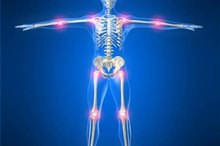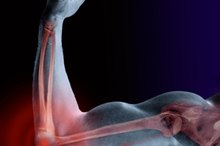What does fact checked mean?
At Healthfully, we strive to deliver objective content that is accurate and up-to-date. Our team periodically reviews articles in order to ensure content quality. The sources cited below consist of evidence from peer-reviewed journals, prominent medical organizations, academic associations, and government data.
The information contained on this site is for informational purposes only, and should not be used as a substitute for the advice of a professional health care provider. Please check with the appropriate physician regarding health questions and concerns. Although we strive to deliver accurate and up-to-date information, no guarantee to that effect is made.
What Is Subchondral Sclerosis?
Subchondral sclerosis is a condition that affects the bones in the joints of people with osteoarthritis. It causes joint pain and immobility due increased bone mass and density in a thin layer of bone beneath the cartilage of joints. Though this condition is chronic and painful, it is easily detectable by a doctor and can be treated a number of ways.
If you are experiencing serious medical symptoms, seek emergency treatment immediately.
Causes
Subchondral sclerosis is a result of another medical condition know as osteoarthritis. Osteoarthritis is the umbrella term for a group of diseases that cause the joints to slowly degrade over time. As the joints degrade they can cause permanent damage to the cartilage in them and the bones around them. Osteoarthritis is a common condition, usually found in older individuals, and is the No. 1 cause of chronic disability in the United States.
- Subchondral sclerosis is a result of another medical condition know as osteoarthritis.
- Osteoarthritis is the umbrella term for a group of diseases that cause the joints to slowly degrade over time.
Features
Degenerative Changes of the Thoracic Spine
Learn More
Osteoarthritis will slowly degrade two main parts inside a joint 1. One of those parts is the cartilage, the spongy connective tissue, and the other part is the subchondral bone, which is a layer of bone just under the cartilage. When osteoarthritis wears away at this part of the body, the body attempts to regrow it, causing an increased density and thickness. This increased thickness in the subchondral layer is known as subchondral sclerosis.
- Osteoarthritis will slowly degrade two main parts inside a joint 1.
- When osteoarthritis wears away at this part of the body, the body attempts to regrow it, causing an increased density and thickness.
Identification
Subchondral sclerosis is easy to identify with an X-ray, which shows subchondral sclerosis as a particularly white region along the line of a joint. The presence of subchondral sclerosis can also be used to identify a progressive stage of osteoarthritis itself.
Effects
Diseases That Affect the Tendons
Learn More
Subchondral sclerosis is a painful condition that can lead to even more joint and bone damage. The extra dense bone can cause increased wear to the joint and inflammation of the area surrounding it. It can also cause bone spurs, which are small, acute bone growths that also cause increased damage and pain to the joint and any remaining cartilage in it. The pain, bone growth and joint damage that are associated with subchondral sclerosis can eventually lead to loss of motion in those joints.
- Subchondral sclerosis is a painful condition that can lead to even more joint and bone damage.
- The pain, bone growth and joint damage that are associated with subchondral sclerosis can eventually lead to loss of motion in those joints.
Treatments
There is no cure for osteoarthritis, the overlying condition that causes subchondral sclerosis, but there are many treatment options designed to slow the damage caused and manage the pain of this condition. Many options involve lifestyle modification, meaning changes such as increased low-intensity workouts, weight loss and education. A number of medications are available, but most either treat the pain or reduce inflammation. Surgery is also an option, whether it is mild arthroscopic surgery to relieve some of the pain, or major joint replacement surgery to restore movement in a joint.
- There is no cure for osteoarthritis, the overlying condition that causes subchondral sclerosis, but there are many treatment options designed to slow the damage caused and manage the pain of this condition.
- Surgery is also an option, whether it is mild arthroscopic surgery to relieve some of the pain, or major joint replacement surgery to restore movement in a joint.
Related Articles
References
- Degenerative Joint Disease
- Mayo Clinic
- Akamatsu Y, Kobayashi H, Kusayama Y, et al. Does subchondral sclerosis protect progression of joint space narrowing in patients with varus knee osteoarthritis? Osteoarthritis Cartilage. 2014;22(Supplement): S362. doi:10.1016/j.joca.2014.02.667
- Crema MD, Cibere J, Sayre EC, Roemer FW, Wong H, Thorne A, Singer J, Esdaile JM, Marra MD, Kopec JA, Nicolaou S, Guermazi A. The relationship between subchondral sclerosis detected with MRI and cartilage loss in a cohort of subjects with knee pain: the Knee Osteoarthritis Progression (KOAP) study. Osteoarthritis Cartilage. 2014;22(4):540-6. doi:10.1016/j.joca.2014.01.006
- Akamatsu, Y.; Kobayashi, H.; Kusayama, Y. et al. Does Subchondral Sclerosis Protect Progression of Joint Space Narrowing in Patients with Varus Knee Osteoarthritis? Osteoarthritis Cartilage. 2014;22(Supplement): S362. DOI: 10.1016/j.joca.2014.02.667.
- Crema MD, Cibere J, Sayre EC, et al. The Relationship Between Subchondral Sclerosis Detected with MRI and Cartilage Loss in a Cohort of Subjects with Knee Pain: The Knee Osteoarthritis Progression (KOAP) Study. Osteoarthr Cartil. 2014;22(4):540-6. doi: 10.1016/j.joca.2014.01.006.
- Li G, Yin J, Gao J, et al. Subchondral Bone in Osteoarthritis: Insight into Risk Factors and Microstructural Changes. Arthritis Res Ther. 2013;15(6):223. DOI: 10.1186/ar4405.







